On the effectiveness of the shooting of the main forces of the Japanese in the battle at Shantung
Before the final article, which concludes my "Tsushima" cycle, devoted to the effectiveness of the shooting of Russian and Japanese forces, I think it is right to digress a little and try to compare the effectiveness of Russian and Japanese fire in Tsushima and at Shantung.
Of course, you need to compare like with like.
And, of course, the skirmishes in the 1st phase of the battle at Shantung, which were conducted mainly at a distance of 60 cables or more, are completely unequal to those in Tsushima. But the second phase of the battle on July 2, 28 began at 1904–40 cables and was gradually reduced to 45, and in the case of the "Retvizan" - even to 24. Therefore, we can say that the conditions in the 17nd phase of the battle on July 2, 28 were to a certain extent similar to those in which the squadrons of Z.P. Rozhdestvensky and H. Togo fought in the 1904st phase of Tsushima, in which the battle began at a distance of no more than 1 cables.
Of course, there were also significant differences, and I will touch on them later.
But we will start by determining the number of shells that hit the Russian ships in the battle of the main forces in the Yellow Sea.
Alas, the question of the number and time of hits on Russian ships in the battle in the Yellow Sea, and in other battles of the Russo-Japanese War, is still open. In order to dot all the “i's” here, you need to work hard in the archives, but, unfortunately, I don’t have such an opportunity: for some reason unclear to me, naval archives are not available in every Russian city. Thus, I can only analyze the available data, in other words, the official history, reports and testimonies of officers of the 1st Pacific Squadron, works of eyewitnesses, as well as the work of modern historians.
As a basis, I take V. Polomoshnov's monograph "The Battle of July 28, 1904 (Battle in the Yellow Sea (Battle of Cape Shantung)." Naval history is grateful to him from the bottom of our hearts, but nevertheless, in my opinion, in some cases the data presented by the respected V. Polomoshnov need clarification and further elaboration.
Before starting the analysis, I present V. Polomoshnov's data without any of my corrections:
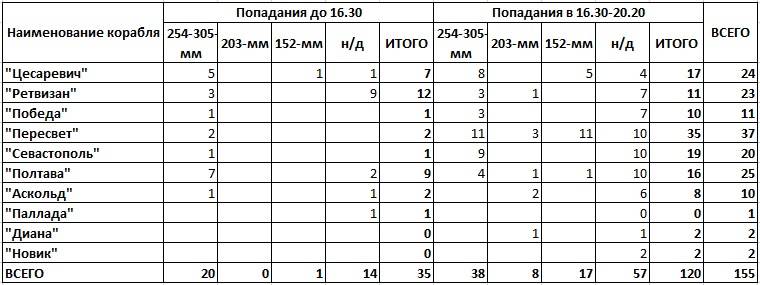
V. Polomoshnov divided the hits to the Russian ships into those that occurred before the beginning of the 2nd phase of the battle, that is, before 16:30, and after it began. This is not exactly the kind of grouping that I need, since after 16:30 the Russian ships took part in several separate clashes, including the breakthrough of cruisers and night attacks of destroyers. I am only interested in those hits that the Russian ships received in the 2nd phase of the battle of the main forces, respectively, they will need to be isolated from the general statistics.
"Tsarevich"
Regarding the statistics of hitting the flagship of Rear Admiral V.K.Witgeft, presented by V. Polomoshnov, I would like to make only one clarification.
The esteemed author attributed one of the two hits of 305-mm shells to the second chimney of the Tsarevich during the second phase of the battle. At the same time, we have eyewitness testimony that this hit was received prior to the start of this phase.
This was reported by the commander of the "Tsarevich" Ivanov 1st and Lieutenant Knorring.
In view of the above, I am transferring one shell hit to the Tsarevich from phase 2 to phase 1.
"Retvizan"
As for the Retvizan, everything is rather confusing, if only because its commander Schensnovich indicated a different number of hits on the ship. So, in a report to the temporarily commander of the Pacific squadron, Schensnovich reported 21 hits on July 28, but then he indicated 23. Probably, the latest data are correct, especially since Schensnovich gave good details on them.
It is noteworthy that such a division of the battle on July 28 is very different from the generally accepted one. However, it is quite obvious that only the last 9 shells hit the Retvizan after 16:30, that is, after H. Togo caught up with the Russian squadron, and the battle resumed.
Accordingly, I reduce V. Polomoshnov's data for the 2nd phase from 11 to 9 hits.
As for the statistics of large-caliber shells that hit the Retvizan, it is not easy to figure it out: there are few explanations for individual hits, and the available information is contradictory.
Therefore, I will start with those of them for which there are no discrepancies in the sources.
There are three of them: two in the 1st phase and one in the 2nd.
For all three hits, the opinion of I.V. Polomoshnov is confirmed by the description of the damage given by Shchensnovich, and I have no other documents that could refute this.
The 1st phase includes the hit of a large-caliber projectile that smashed the commander's cabin and two more cabins. Schensnovich does not indicate the caliber of the projectile, but, taking into account the hole 2 * 2 m, it should be assumed that it was a 305-mm projectile. NN Kuteinikov points out the same, and I have no reason to object.
Also in the 1st phase, a 305-mm projectile hit the Retvizan in the deck at the stern, which is why it was pierced, while the next deck was also pierced by shrapnel. This is probably taken from N.N.Kuteinikov, who claimed that the hit was 305 mm.
In the 2nd phase of the battle (after 16:30), a heavy shell hit the 305-mm bow turret: in terms of the nature of the damage it was no less than 254-mm, but, most likely, it was still a XNUMX-inch shell.
Regarding the rest of the hits, unfortunately, there is no such clarity.
Take, for example, a large-caliber projectile that damaged the 51 mm armor plate that protected the waterline in the bow of the battleship, and opened water access to the infirmary and the conductor's wardroom. In the description of the damage to the Retvizan, Schensnovich indicates that this shell hit in the 1st phase of the battle, but in his report to the temporary commander of the Pacific squadron - that the hit was after 17:10. According to V. Polomoshnov, the "Retvizan" received this damage in the 1st phase, and I think the same, because the report was written "hot on the trail", it was dated July 29, 1904, and the damage was described in a document drawn up on August 5 of that the same year, that is, "with a cold head."
Another 305-mm shell hit the lower casemate of the 152-mm gun. Armor 127 mm gave 2 cracks, one of them is through. According to N.N.Kuteinikov, the projectile was 305 mm, which can hardly be questioned. According to V. Polomoshnov's description, shell fragments disabled the fire control devices on the starboard side. If this is the case, then Retvizan received this hit in the 2nd phase, since, according to Schensnovich, these devices were out of order in the 2nd phase of the battle.
But I have not found data that would allow to confirm or refute the statement that the devices were broken by fragments of this particular shell. So - I leave him in the 2nd phase, but I cannot vouch for it.
Another heavy 305-mm projectile hit the first chimney of the Retvizan. V. Polomoshnov indicated that this hit occurred in the 2nd phase of the battle, but Schensnovich indicates that both smoke works were damaged in the 1st phase of the battle, and not in the second.
Total: V. Polomoshnov indicated 12 hits to the Retvizan in the 2nd phase, of which 3 were 305-mm, but I come to the conclusion that these figures are more modest - 9 hits, of which 2 were 305-mm.
"Victory"
V. Polomoshnov, according to his own words, took the descriptions of the damage of this ship from R. M. Melnikov: according to his data, 11 shells, including 4 of 305-mm caliber, hit this battleship. Of these, one 305-mm hit the ship in the first phase of the battle, the rest - in the second.
Unfortunately, only 9 hits are described in detail in the report of the commander of the ship Zatsarenniy. However, it follows from the context that the Pobeda commander described in the report only those Japanese hits that led to the formation of holes in the hull or deck. But there were others, about them Zatsarenny spoke like this:
Accordingly, the canonical 11 hits can be questioned: for nine of them we have a detailed description, and “several” in Russian is usually not equivalent to “two”. It can be assumed that there were 12-13 hits in Pobeda or even more. On the other hand, it is quite possible that R. M. Melnikov, using the archival data, found that some of these hits were fragmentation, and therefore did not count them.
Now let's look at the number of heavy shells hitting the ship. Two of them, in my opinion, are completely reliable - one shell knocked out a seven-pound plug from the 229-mm armor belt, the second - pierced the 102-mm armor of the upper armor belt. Only 305-mm Japanese shells were capable of this.
But about the rest of the hits - there are doubts.
V. Polomoshnov believes that the shell that hit the unarmored hull of the battleship in the area of the living deck in the bow and caused flooding of the bow mine apparatus had a caliber of 305 mm. I strongly doubt that this is so: the projectile left a hole only 25 * 32 inches, that is, 64 * 81 cm, and of the internal damage, only a depressed bulkhead between two cabins and shrapnel damage to two ventilation pipes are mentioned. In my opinion, this indicates, rather, a 152-mm projectile.
The fourth and last hit by a 305-mm projectile, according to V. Polomoshnov, the ship received in the stern. Here's a description of this hit:
Apparently, the above description was taken from N.N.Kuteinikov's book, since the above passage is quoted from it almost word for word.
As you can see, the description is very detailed and replete with many details, but there is one caveat - there is not a word about this hit in the description of Zarenniy's damage.
Accordingly, there is already one of two things.
Perhaps N.N. Kuteinikov made some mistake, for example, he pointed out that he hit another ship, which, in my opinion, is highly doubtful.
On the other hand, the version that Zatsarenny missed this damage is also unlikely: his "Description" was presented on August 12, 1904, that is, it seems to have been written not in the heat of battle, but cold-headed, according to the results post-battle inspection of "Victory".
Nevertheless, I am inclined to consider this a mistake of Zatsarenniy, since the commander after an unsuccessful battle had a lot of trouble, and writing explanatory notes "upstairs" could be perceived as an unnecessary burden.
From the above, we can conclude that even the most detailed documents of the past, no matter how official they are, are sometimes not completely reliable and need to be cross-checked.
Thus, out of 4 hits of 305-mm, which V. Polomoshnov indicates, I am absolutely sure of three.
But there is one more hit that I tend to consider 305 mm, and this is No. 3 in the description of Zarennoy.
The projectile hit the rear chimney, pierced both the chimney and the casing, and the dimensions of the hole in the chimney were 12 * 9 feet or 2,75 * 3,65 m. In my opinion, the indicated dimensions correspond exactly to a twelve-inch projectile.
Thus, I am inclined to believe that Pobeda received at least (but possibly more) 11 hits in battle, of which 4 were 305-mm, although these are not the hits indicated by V. Polomoshnov.
And also I doubt their distribution over the phases of the fight.
According to V. Polomoshnov, in the 1st phase of the battle, a 305-mm projectile hit Pobeda, knocking out the plug from the 229 mm of the ship's armor belt and causing flooding of the coal pit and three compartments, and all other hits occurred during the 2nd phase ... However, Zatsarenniy's description directly states that the hit to the main armor belt occurred not in the 1st, but in the 2nd phase of the battle. On the other hand, Zatsarenny in his report to Rear Admiral Loshchinsky indicates that in the 1st phase of the battle, 75-mm guns Nos. 9 and 11 were damaged by shrapnel.
So, according to the description of the damage done by Zatsarenniy, the specified guns are mentioned only once, when describing hit No. 5. True, this refers to damage to the semi-pads of these guns, but still it can be assumed that the guns themselves were damaged by this hit.
However, hit number 5 was hardly 305 mm: the hole from this projectile is relatively small, 66 by 48 inches or 167 * 122 cm, which is more typical of a 203 mm, perhaps 254 mm projectile, but hardly more. Therefore, in my distribution of hits, I take into account one hit on Victory with a caliber of "203 mm and above" before the beginning of the 2nd phase, and the rest of the hits during it.
In view of the above, I believe that the number of hits in the 2nd phase of the battle V. Polomoshnov indicated correctly - 10, but of them there were 4 caliber 254-305-mm, and according to V. Polomoshnov - only 3.
Of course, the dear reader has the right to draw other conclusions.
"Peresvet"
Canonical can be considered 37 hits, listed in a copy of the clipping of the artillery form of the battleship, and from there already got into the work of the historical commission on the description of actions fleet during the war of 1904-1905.
However, I only take 34 hits into account. Since one of the listed (among the 37th) was fragmentation, from a shell that exploded next to the ship, and the other two were achieved by Japanese destroyers during night attacks. Consequently, 34 direct hits remain on the share of Togo's heavy ships.
Another nuance - V. Polomoshnov believed that a 305-mm projectile hitting the foremast above the navigator's cabin and destroying Barr and Stroud's rangefinder landed in Peresvet before the start of the 2nd phase. I am not sure about this, because the artillery form signed by Cherkasov explicitly states that in the first phase only one shell hit the battleship.
On the other hand, further the same Cherkasov indicates that the range finder was destroyed "at the beginning of the battle", that is, it contradicts itself. I admit that "at the beginning of the fight" may refer to the beginning of the second phase, when the fight resumed, but I fully admit that I could be wrong in this matter.
Nevertheless, I believe it is legitimate to reduce the number of hits to "Peresvet" in the 1st phase of the battle from two to one, transferring it to the 2nd phase. In this case, in the 2nd phase, 33 shells hit the ship, 12 of them with a caliber of 254-305 mm.
Sevastopol
One thing is absolutely certain - in the 1st phase of the battle, "Sevastopol" was hit by 305-mm shells in the armor belt. All the rest, alas, raises questions.
When analyzing the damage to Sevastopol, V. Polomoshnov, unfortunately, contradicted himself: in one place he claimed that a total of 17 shells hit the ship, of which 7 were heavy (one was 305 mm, the rest were 254-305 mm), with six 254-305 mm hitting the battleship in the 2nd phase. However, he further wrote that there were up to 20 hits in Sevastopol, of which there were 305-mm. However, perhaps this is just a typo, since literally in the very next sentence he writes: “Out of nine hits with a caliber of 10 -dm one was armor-piercing. "
Von Essen, the commander of the Sevastopol, directly indicated only 3 hits with large-caliber shells. However, this cannot be considered an exhaustive list, since von Essen, like Schensnovich, focused on the description of damage, and not on the calibers of the shells that caused them - for the most part, he does not specify the caliber of the shell that caused this or that damage. Thus, von Essen's information should be supplemented by other sources, such as N.N.Kuteinikov, for example. The latter still had the opportunity to personally observe the places where the shells hit.
So, in addition to the very first hit with a 305-mm caliber, von Essen points to two more hits in the vertical plates of the armor belt: one in front of the 152-mm turret, the second behind the other turret. At the same time, von Essen points out that the hit "behind" was a large-caliber projectile, and the second broke off the upper corner of the 5-inch slab.
At the same time, N.N.Kuteinikov reports that the indicated plate was hit by two 305-mm shells, which exploded on the upper edge of the plate, pressed it, broke off a part and cut the unarmored side with fragments. Of course, it is not easy to believe that two shells hit the same plate: but the descriptions of the damage are such that it was really possible to diagnose the hits of two shells from them.
Another large-caliber shell (by von Essen) hit near the waterline and destroyed the wardroom. V. Polomoshnov counted it as a 305 mm, and I completely agree with that.
In total, there are 5 quite reliable hits with a caliber of 305 mm, but then questions begin.
V. Polomoshnov claims that according to the results of the examination of the Sevastopol in Port Arthur, 3 more hits were found in its armor belt below the waterline, as a result of which the frames were bent and the armor bolts flowed. In principle, such damage is quite consistent with hits from 305-mm high-explosive shells.
Another 12-inch hit on V. Polomoshnov is a ricochet from the roof of the bow turret of the main caliber, as a result of which a "furrow" about an inch deep and about 6 inches long remained on the turret. But this is most likely a banal mistake - the fact is that in the book by N.N.Kuteinikov, which was used by a respected author, this projectile is listed as 12-centimeter (12 c / m), and not 12-inch (12 dm) ... Or, perhaps, V. Polomoshnov did it deliberately, suspecting a typo in N. N. Kuteinikov. I tend to attribute this shell to an unknown caliber.
In total, 9 hits with a caliber of 305 mm are recruited. In fact, there could have been more of them, since some of the other hits on the ship are characterized by the extensive damage that suggests large-caliber shells. And, perhaps, there were fewer of them, if any of the four listed last hits were less than 305 mm.
With that said, I settled on 20 hits, including at least 5 high-caliber shells.
"Poltava"
I cannot add anything about this ship to the data provided by V. Polomoshnov.
"Askold"
According to V. Polomoshnov, the ship received 10 direct hits, not counting close explosions.
But he received 8 of them during the breakthrough of cruisers, that is, outside the battle of the main forces, which means that we are not interested in them.
But the first two hits on "Askold" happened before the beginning of the second phase, and V. Polomoshnov defined them as one 2-mm projectile (into the chimney) and one hit of an indeterminate caliber.
Reitenstein, in a report to the governor of September 1, 1904, indicated that the second projectile was 305-mm, and the same opinion was held by midshipman Medvedev, arguing that other calibers, due to the long range, would not reach the cruiser. There is also evidence that the 152-mm guns of "Askold" during this period of the battle could not reach the enemy.
The shell hit completely destroyed the chief navigator's cabin (the box with the chronometers miraculously survived), but that was all. Thus, this, of course, could have been a 305-mm projectile, but it could have been 203-254-mm.
I will classify it as "203mm or higher" hits, since it is obvious that this shell was heavy.
"Diana"
The cruiser received 2 hits.
One shell of an unknown caliber hit the Temperley arrow at 17:20, the second, of a large caliber (according to V. Polomoshnov - 254 mm), hit the ship at 19: 20-19: 40.
Thus, the first hit refers to the 2nd phase of the battle, while the second shell hit the ship after the end of the battle of the main forces, and I do not take it into account.
"Novik"
This cruiser was damaged by two shells, but they hit it during the breakthrough of Reitenstein's cruisers, that is, they do not belong to the battle of the main forces.
Conclusions
After all the changes made, the hits on the Russian ships received by them in the battle of the main forces were distributed like this:
In the first phase of the battle, the Japanese achieved a relatively small number of hits, but most of them were 1-254-mm caliber, which is not surprising given the large distances in this phase.
In the second phase, the Japanese, as they say, went for broke. Overtaking the formation of Russian battleships at a relatively short distance, H. Togo put himself in an extremely disadvantageous tactical position, but he simply had no other way to stop the Russian squadron before dark. The bet on the skill of the Japanese gunners has fully justified itself - the number of hits with a caliber of 2-254 mm in comparison with the 305st phase increased by 1, and all hits by 1,65.
All in all, the gunners of the 1st Combat Detachment and Yakumo in the 2nd phase of the battle planted 104 shells into our ships.
The indicated figure does not claim to be absolute accuracy.
Perhaps a couple or three of the indicated 104 shells hit the Russian ships from the guns of the 5th Combat Detachment, or Asama achieved a hit, then the effectiveness of the Japanese main forces would be slightly lower.
On the other hand, it is possible that more shells hit Pobeda than is generally believed, so I think 104 hits in the 2nd phase is very close to the truth.
How did the Russian artillerymen respond?
To be continued ...
- Andrei from Chelyabinsk
- from the site tsushima.su
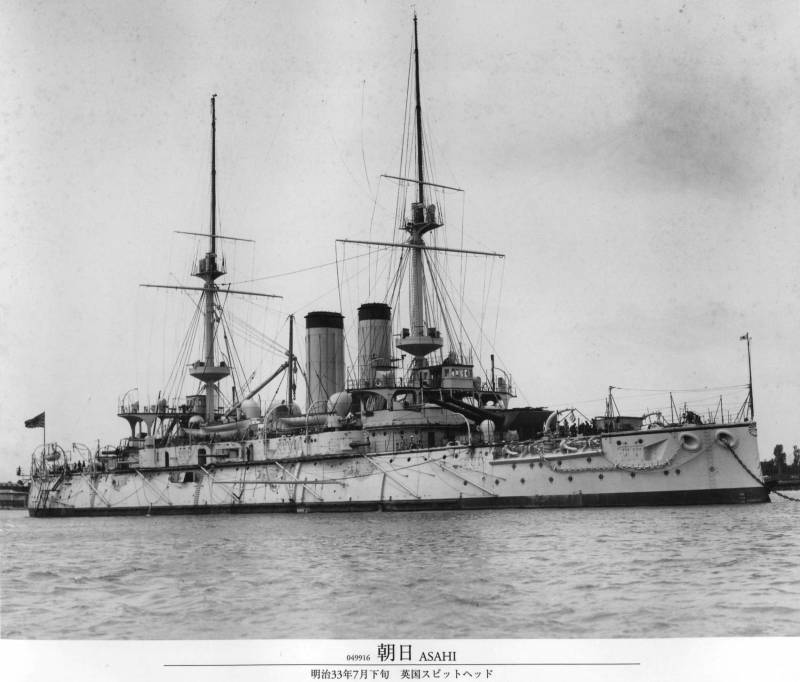
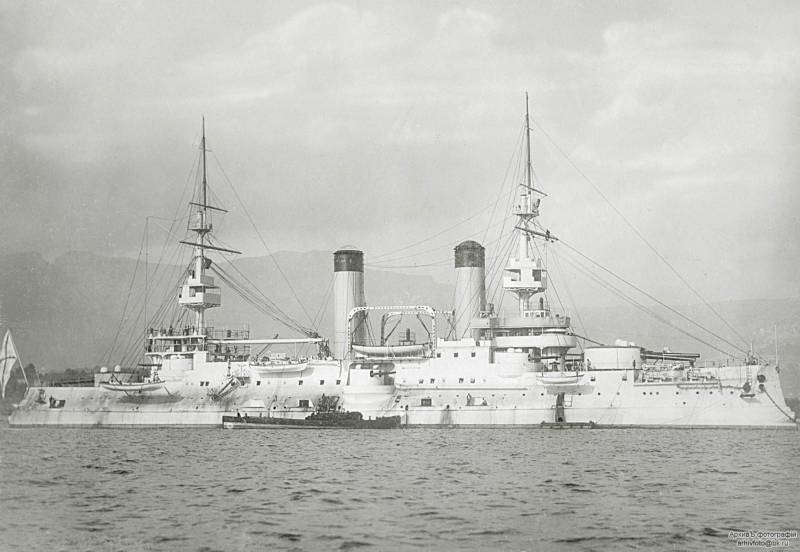
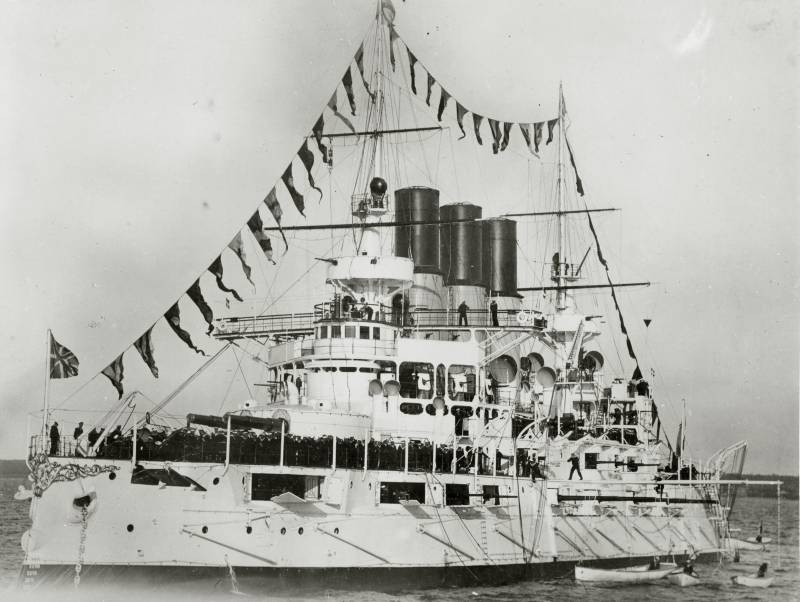
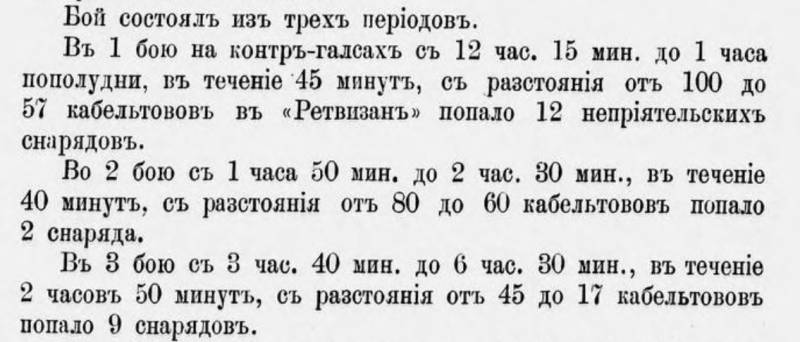
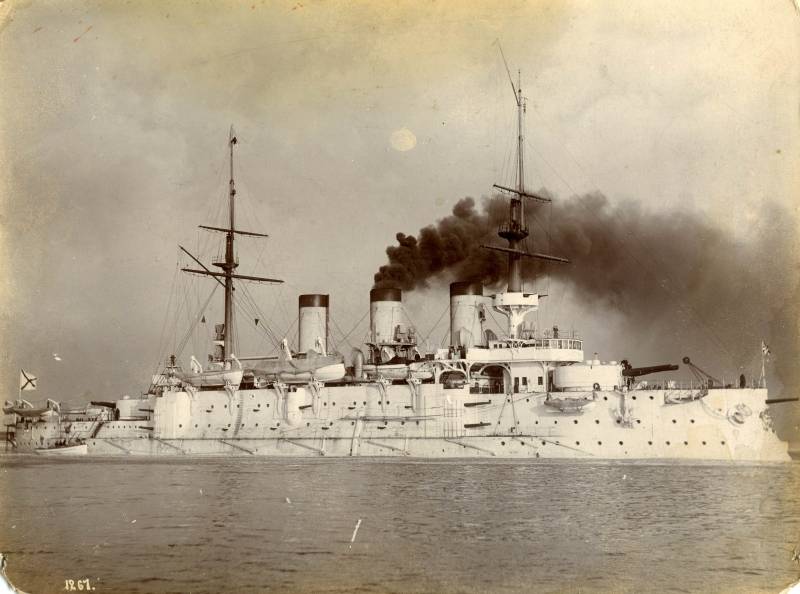
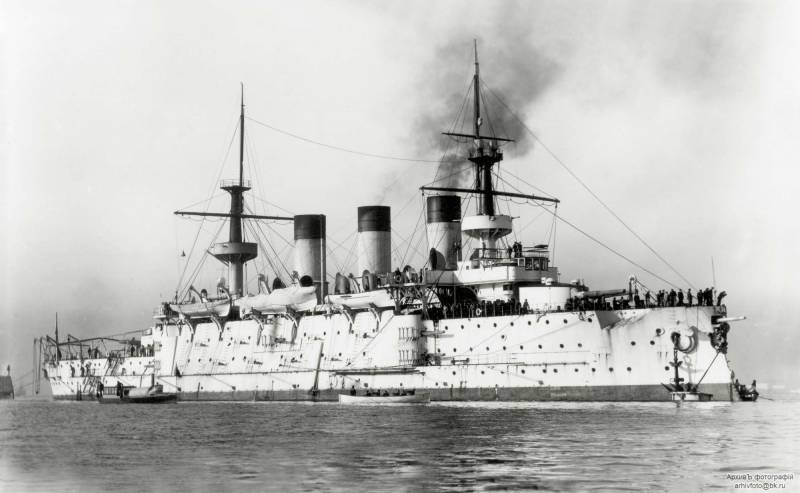
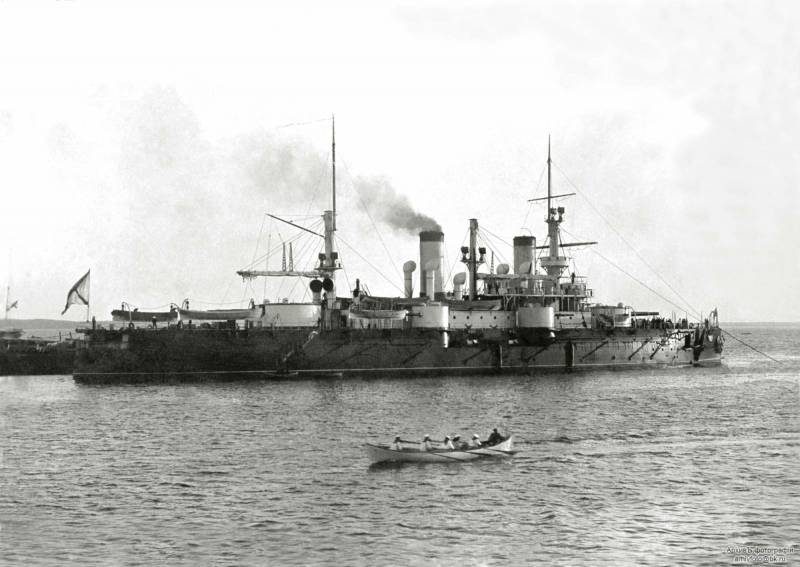
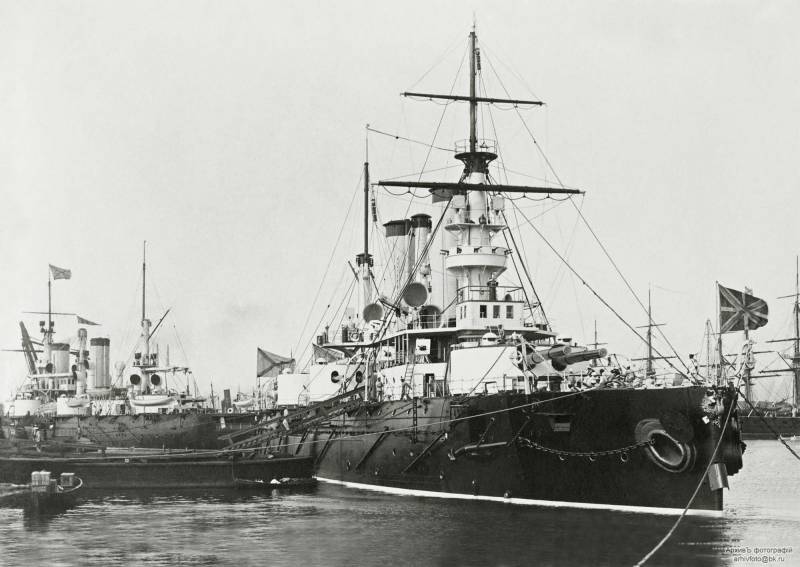

Information